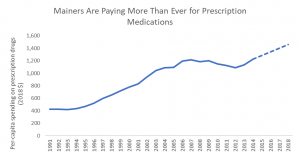Everyone deserves access to life-saving medication. Pharmaceutical companies develop new and innovative treatments, but this doesn’t give them the right to strongarm Mainers into paying sky-high prices for drugs. LD 1499, “An Act To Establish the Maine Prescription Drug Affordability Board,” is an important step in reigning-in the runaway cost of prescription medication. Maine has processes in place to ensure monopolies such as power companies and health insurers can’t charge exorbitant prices for their products, and we should treat pharmaceutical manufacturers in the same way.
Health care costs are squeezing Mainers’ budgets tighter every year. Since 1997, health care has increased as a share of consumer spending from 15 percent in 1997 to 18 percent in 2017.[1] Spending on prescription medications, especially where the prices are artificially high, reduces the ability of Mainers to do everything from putting food on the table to saving for the future.
The cost of prescription drugs has been rising faster than almost any other health care expense in recent years.[2] Per-capita spending on prescription drugs has risen roughly three times as fast as regular increases in the cost of living,[3] with the price of common brand-name drugs skyrocketing even faster. A U.S. Senate report found that the 20 most commonly-prescribed brand-name drugs purchased through Medicare Part D had average price increases 10 times the rate of inflation between 2012 and 2017.[4]

If you’re a worker whose wages are barely increasing or a senior on a fixed income, what are you supposed to do when your life-saving medicine is harder to afford every year?
While the Affordable Care Act has helped more Americans obtain health insurance and reduced the out-of-pocket costs for many who are insured, many still struggle to afford prescription medications. For some Mainers, paying for prescriptions means going without necessities such as food, rent, or utilities. For others, it means finding ways to stretch out their supply of medicine. Among non-elderly adults, 11 percent either skipped doses or took smaller doses of their medicine because they couldn’t afford the correct course of treatment.[5] Another 7 percent needed a prescription but didn’t get one at all because they couldn’t afford it.[6] The price of prescription drugs has become a near-insurmountable barrier to good health for millions of Americans and tens of thousands of Mainers.
The Public Utilities Commission asks electric power companies to justify rate increases. The Bureau of Insurance reviews rate increases for health insurers. These oversight agencies protect Mainers from unfair electrical prices and insurance premiums. LD 1499 establishes a similar oversight for prescription medications. Americans spend much more for the same prescription drugs than patients in other countries. A study of commonly prescribed medications found that the studied drugs were twice as expensive in the United States than in Canada, Australia, or the United Kingdom. The United States even overpays compared to countries where health care is funded primarily though multiple private insurers, such as Germany or Switzerland.[7] The big difference between the U.S. and these other wealthy countries is that the U.S. does not regulate the price of prescription medications. LD 1499 would adopt some of the practices which are proven to work in other countries.
Regulating the price of prescription drugs is also the approach taken by the federal government in several of its programs, most notably the Veterans’ Health Administration.[8] Studies estimate that the VA’s ability to negotiate drug prices helps the program provide prescription drugs at a cost 40 percent below those in the private market.[9] There is bipartisan agreement that regulating prescription drug prices is essential to lowering costs for patients; President Trump’s administration in Washington is giving Medicare more flexibility to negotiate prices.[10]
MECEP supports LD 1499 as a proven approach to putting the brakes on the runaway costs of prescription drugs, which are putting Mainers’ health at risk. We urge lawmakers to support this legislation.
Notes
[1] U.S. Bureau of Economic Analysis, Personal Consumer Expenditures.
[2] Center for Medicare and Medicaid Services, National Health Expenditure Survey (national data). Per-capita costs for prescription drugs increased an average of 4.8 percent annually between 2012 and 2017, behind only the administrative costs of health insurance (6.6 percent) and care in residential and other non-home, non-provider settings (5.4 percent).
[3] The Consumer Price Index for 2012-2017 increased by 1.35 percent annually on average between 2012 and 2017.
[4] US Senate Homeland Security and Government Affairs Committee, Minority Office, “Manufactured Crisis: How Devastating Drug Price Increases Are Harming America’s Seniors,” nd. Web. Available at https://www.hsgac.senate.gov/imo/media/doc/Manufactured%20Crisis%20-%20How%20Devastating%20Drug%20Price%20Increases%20Are%20Harming%20America’s%20Seniors%20-%20Report.pdf
[5] US Centers for Disease Control, National Center for Health Statistics, Data Brief 333, “Strategies Used by Adults Aged 18-64 to Reduce Their Prescription Drug Costs, 2017,” March 2019. Web. Available at https://www.cdc.gov/nchs/products/databriefs/db333.htm
[6] National Health Interview Survey 2017 data via IPUMS.
[7] Dana Sarnak et al, “Paying for Prescription Drugs Around the World: Why Is the U.S. an Outlier?” Commonwealth Fund, Oct 2017. Web. Available at https://www.commonwealthfund.org/sites/default/files/documents/___media_files_publications_issue_brief_2017_oct_sarnak_paying_for_rx_ib_v2.pdf
[8] Chester Good & Michael Valentino, “Access to Affordable Medications: The Department of Veterans Affairs Pharmacy Plan as a National Model,” American Journal of Public Health, 2007 Dec; 97(12): 2129-2131. Available at https://www.ncbi.nlm.nih.gov/pmc/articles/PMC2089089/
[9] “Comparing the Costs of the Veterans’ Health Care System With Private-Sector Costs,” Congressional Budget Office, Dec 2014. Web. Available at https://www.cbo.gov/sites/default/files/113th-congress-2013-2014/reports/49763-VA_Healthcare_Costs.pdf
[10] “Trump Administration Gives Medicare New Tools to Negotiate Lower Drug Prices for Patients,” US Department of Health and Human Services, Aug 7, 2018. Web. Available at https://www.hhs.gov/about/news/2018/08/07/trump-administration-gives-medicare-new-tools-to-negotiate-lower-drug-prices-for-patients.html



